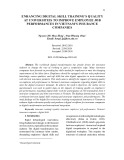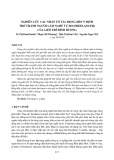
71
Tạp chí Khoa học - Trường Đại học Quy Nhơn, 2020, 14(2), 71-78
Nâng cao chất lượng nguồn nhân lực Logistics thông qua
việc kết nối sinh viên với các doanh nghiệp Logistics
Nguyễn Minh Quang1, Văn Công Vũ2,*
1Học viện chính trị Quốc gia Hồ Chí Minh, Việt Nam
2Trường Đại học Kinh tế - Đại học Đà Nẵng, Việt Nam
Ngày nhận bài: 19/01/2020; Ngày nhận đăng: 04/04/2020
TÓM TẮT
Hiện nay, vấn đề đào tạo nguồn nhân lực chất lượng cao cho lĩnh vực Logistics đang được các cơ sở giáo
dục và doanh nghiệp đặc biệt quan tâm, nhất là trong bối cảnh hội nhập quốc tế và tác động của cuộc cách mạng
công nghiệp lần thứ tư ngày càng sâu rộng. Để nhân lực Logistics cung ứng cho thị trường lao động đáp ứng đủ
kiến thức chuyên môn và kinh nghiệm thực tế, việc tăng cường kết nối, hợp tác giữa nhà trường và các doanh
nghiệp dịch vụ Logistics là yêu cầu cấp thiết đang được các cơ sở đào tạo nỗ lực thực hiện. Bài viết bàn sâu thêm
về thực trạng nguồn nhân lực Logistics ở Việt Nam hiện nay và khẳng định tầm quan trọng của việc kết nối giữa
nhà trường và các doanh nghiệp Logistics trong vấn đề đào tạo nguồn nhân lực. Từ đó, tác giả kiến nghị một số
giải pháp mang tính định hướng trong việc tăng cường sự kết nối giữa sinh viên với các doanh nghiệp Logistics
thông qua nhà trường
Từ khóa: Logistics, nguồn nhân lực, sinh viên, doanh nghiệp.
*Tác giả liên hệ chính.
Email: vuvc@due.edu.vn
TRƯỜNG ĐẠI HỌC QUY NHƠN
KHOA HỌC
TẠP CHÍ

72 Journal of Science - Quy Nhon University, 2020, 14(2), 71-78
Improving the quality of Logistics human resources
through connecting students with the Logistics enterprises
Nguyen Minh Quang1, Van Cong Vu2,*
1Ho Chi Minh National Academy of Politics, Vietnam
2 Da Nang University of Economics, Vietnam
Received: 19/01/2020; Accepted: 04/04/2020
ABSTRACT
Currently, the issue of producing high-quality human resources for Logistics is receiving special attention
by educational institutions and enterprises, especially in the context of international integration and the impact of
the fourth industrial revolution which becomes more extensive. In order for Logistics labor force to supply the
labor market with adequate professional knowledge and practical experience, strengthening the connection and
cooperation between educational institutions and Logistics service enterprises is an urgent requirement carried
out by educational institutions. The article further discusses the current situation of Logistics human resources
in Vietnam and affirms the importance of connecting between educational institutions and Logistics enterprises
in producing human resources. Hence, the author proposes a number of directional solutions in strengthening the
connection between students and Logistics enterprises through the educational institutions.
Keywords: Logistics, human resources, student, enterprise.
* Corresponding author.
Email: vuvc@due.edu.vn
1. INTRODUCTION
Currently, Logistics human resources are
in serious shortage. In the period of 2017-
2020, the country needs about 20,000 high-
quality workers in Logistics and supply chain
management. Forecasting to 2030, the number
of new workers needed in the Logistics industry
amount to 200,000 highly qualified employees
meeting all requirements of skills, professional
knowledge and English proficiency.1 However,
human resources do not meet the requirements of
logistics services. In details, they are inadequate
in quantity and weak in quality. Logistics human
resources lack comprehensive knowledge and
ICT qualifications still limited, not keeping up
with the development progress of the world
Logistics. Their logistics English proficiency is
still weak. In details, only about 4% of human
resources are proficient in English, 30% of
businesses have to retrain employees.2 In fact, the
cohesion between enterprises and universities is
not much and not practical, and graduates have
not met the needs of the business...
Currently, there are many studies of
domestic and foreign experts, scientists on the
training of Logistics human resources such as:
Capacity building for tourism and logistics:
redefining the role of human resources,3 Human
resource management issues associated with the
globalization of supply chain management and
logistics;4 Training on developing Vietnam's
Logistics human resources,5 Human Resources
Development Solutions for Vietnam's logistics
industry,6... The works show the serious research
QUY NHON UNIVERSITY
SCIENCE
JOURNAL OF

73
QUY NHON UNIVERSITY
SCIENCE
JOURNAL OF
Journal of Science - Quy Nhon University, 2020, 14(2), 71-78
results of scientists on Logistics human resources
and development solutions, improving the
quality of Logistics human resources. However,
there has not been any work focusing on analysis,
and in-depth study on the solution of connecting
universities with Logistics enterprises to improve
the quality of human resources in this field.
Businesses and universities must cooperate
and collaborate in training. There are shares
and connections to find a common voice, so
that students can best meet the requirements
of employers after graduation. This is one
of the important factors contributing to the
effectiveness of the training. Therefore, the
issue of connecting students in universities with
Logistics enterprises to contribute to improving
the quality of Logistics human resources training
is extremely necessary.
The article is aimed at students at the
training institutions (universities) specializing
in Logistics in Vietnam today. Analyzing the
current situation of Logistics human resources
training in Vietnam in the period of 2015 - 2020,
we will give solutions to orienting the connection
between universities and Logistics enterprises to
2025 and vision to 2030.
To solve the research problem, the author
mainly uses the method of aggregating and
analyzing secondary data sources, from which
assessing the real situation of the problem and
providing corresponding solutions.
2. CONTENT
2.1. Logistics and Logistics human resources
At the XIth National Assembly of the Socialist
Republic of Vietnam, of the 7th Session, of
June 14, 2005, passed the 2005 Commercial
Law, which specifies the concept of Logistics
services. In Article 233, Section 4, Chapter VI
of the Commercial Law dated June 14, 2005
stipulating “Logistics services are commercial
activities, whereby traders organize the
implementation of one or more stages including
receive goods, transport, warehousing, storage,
customs clearance, other paperwork, customer
advice, packaging, coding, delivery or other
services related to the goods as agreed with the
customer to enjoy the remuneration”.7
Logistics and supply chain management
(SCM) play an important and indispensable role
in the production, circulation and distribution
of goods. It helps manufacturers capture timely
and accurately the needs of customers and boost
the flow of goods, cash flow and information
from suppliers, factory, transporter, warehouse
through wholesale distribution channels and
retail distribution to end-users more smoothly.
Besides, through Logistics and supply chain
management, businesses can reduce a large
amount of cost, while satisfying customer needs
and improving the brand awareness of the
business.8
The theory of management has affirmed
that people are precious assets. In the field of
Logistics, human resources are also the core
factor determining the success or failure of the
organization, management and operation process
of Logistics enterprises. These human resources
are resources that relate to the general population.
It is an important part of the population and
plays a vital role in creating material and
spiritual wealth for society. Depending on the
industry, the human resource requirements may
vary, therefore, the size of human resources
is also different. “With an approach based
on human ability to work: Human resource is
the labor capacity of the society, of all people
with normal developed bodies who are able
to work”.9 Thus, Logistics human resources
are the labor capacity of society in the field of
Logistic, which are all people who are capable
of participating in labor in Logistics enterprises
with normal physical heath.
The quality of human resources is a
combination of the qualities and strengths
of laborer who are willing to offer them in
the socio-economic development process. It
includes important elements such as: physical
strength, intellect, ethics, competence, skills and
aesthetics of workers. Each of these elements has

74
TRƯỜNG ĐẠI HỌC QUY NHƠN
KHOA HỌC
TẠP CHÍ
Tạp chí Khoa học - Trường Đại học Quy Nhơn, 2020, 14(2), 71-78
a certain position, role and effect in creating the
quality of human resources, but they are always
related, intertwined impact, complementing each
other to create the comprehensive development
of human resources.10
High quality human resources in the
field of Logistics are people who have to meet
the requirements of the market (required by
domestic and foreign Logistics enterprises).
Those requirements are: expertise in Logistics,
economics, information technology, foreign
languages; ability to find, create jobs and work
safely, personal and teamwork skills; good
working attitude and behaviors, responsibility for
the work. The most special quality is the creativity
to find appropriate solutions and to adapt to new,
complex situations of the work place.
High quality human resources play a very
important role in the development of Logistics.
That is one of the factors determining success
and a fundamental, comprehensive development
of Logistics activities, creating high labor
productivity. High quality human resource can
shorten the lagging distance, serving supply-
demand connection to promote economic growth
and accelerate the cause of industrialization and
modernization of the country, achieving the
goal of sustainable development. Improving
the quality of human resources is a necessary
condition for our country's logistics field to
integrate into the world.
2.2. Status of Logistics human resources and
the need to connect students with Logistics
businesses
According to data from Vietnam Logistics
Report 2018 by Ministry of Industry and Trade,
currently, there are about 30,971 enterprises
operating in the field of Logistics services,
including about 4,000 enterprises operating
domestic and international freight, mostly small
and medium enterprises.11 Logistics business
activities include many types of services, dividing
into groups such as: Loading and unloading
containers; Warehouse; delivery service; Cargo;
other service groups; analysis and verification ...
Table 1. Logistics enterprises of Vietnam by scale
Number
BUSINESS
SCALE
(person)
BUSINESS
NUMBER
(enterprise)
RATIO
(%)
1Under 5
people 12.025 38,83
2From 5 to 9
people 8.400 27,12
3From 10 to 49
people 8.781 28,35
4From 50 to
199 people 1.385 4,47
5From 200 to
299 people 152 0,49
6From 300 to
499 people 114 0,37
7From 500 to
999 people 74 0,24
8From 1.000 to
4.999 people 32 0,1
9Over 5,000
people 80,03
Source: Author compiled according to
Vietnam Logistics Report 2018 - Ministry of Industry
and Trade
Currently, with such a large number of
Logistics service providers in Vietnam, the
demand for Logistics human resources continues
to increase over the years. If not promptly met,
this human resource can be assessed as a serious
lack. As of 2018, the number of Logistics
enterprises in Vietnam was 30,971 enterprises.
According to the table, it can be estimated that
the average size of human resources in Logistics
enterprises in Vietnam is about 20 people/
enterprise. The average human growth rate in
Vietnam Logistics enterprises is about 7.5%,
then the human resource needs of enterprises
providing Logistics services in the period from
2018 to 2030 (13 years) will be 30.971 x 20 x
(1 + 0.075)13 = 1.585.971 people.11

75
QUY NHON UNIVERSITY
SCIENCE
JOURNAL OF
Journal of Science - Quy Nhon University, 2020, 14(2), 71-78
In the current period, it can be said that
Vietnam's logistics human resources are not only
lacking in quantity but also weak in quality. This
is not satisfactory for a service industry with a
scale of over 40 billion USD / year, equivalent to
17-18% of the country's GDP.12
Survey results of the Ho Chi Minh City
Development Research Institute on the quality
of Logistics human resources show that, up to
53.3% of businesses lack qualified staff and
logistics knowledge, 30% of businesses have
to retrain their employees and only 6.7% of
businesses are satisfied with their expertise.
The survey results of the National
Economics University's Research and Economic
Development Institute also noted, up to 80.26%
of employees in Logistics businesses are trained
through daily jobs, 23.6% of employees attend
in-country training courses, 6.9% of staff are
trained by foreign experts, only 3.9% have
participated in training courses abroad.6
However, it can be seen that, one of the
current problems is that although there is a
shortage of Logistics personnel, many businesses
after recruiting workers in this field must spend
a lot of time and money conducting retraining.
The cause of this problem is that many cases do
not meet the requirements on skills to use and
operate modern machinery and equipment for
international Logistics and e-commerce services.
Besides foreign language skills, information
technology is also one of the obstacles, causing
Logistics human resources to have many
difficulties in manipulating and communicating
with colleagues and foreign partners. The fact
that this situation exists and has been highlighted
in recent years is due to the skills that the trained
workers in the school do not meet the recruitment
needs of enterprises, the training process has
not kept up with the needs of the labor market;
the equipment and facilities in the training
facilities have not kept up with the changes of
current machines and technologies. Especially
in the context of the fourth industrial revolution,
there is more and more profound influence,
the rise of new technologies such as artificial
intelligence, big data, internet of things..., which
requires machines and technology of businesses
to have continuous improvements to avoid
backwardness, obsolete. Therefore, the problem
of logistics human resources training, which
is qualified to meet the requirements of the
stormy development of science and technology,
becomes even more difficult.
2.3. Situation and difficulties in the training of
Logistics human resources in Vietnam
Currently, there are 23 Logistics vocational
training institutions nationwide.13 Many
universities provide human resource training
in Logistics, including regular, master's and
doctoral programs, with professional and
methodical training program. Besides, some
schools having high quality training programs
and foreign links, bring advanced academic
environment for students.
However, there is a significant shortcoming
that each training school has its own program,
based on the strengths of the schools that
have not yet originated from the practical
requirements of the Logistics industry. It can be
seen that, in reality, Logistics students of many
training institutions, despite their specialization
in Logistics and supply chain industry, do
not know about warehouse management
software and have no deep knowledge about
bar codes, for example, the case of Lazada
Express Vietnam Company.14 Representative of
Lazada Express Vietnam Company said many
of them are surprised to operate a warehouse
that applies modern equipment technology to
serve e-commerce or is quite confused in how
to classify goods packaging to meet standards.
In addition, for some simple jobs related to
Logistics such as handling forklifts, operators
did not have to use electronic equipment before.
The requirement of the business for this position
is much higher now. In addition, many Logistics
workers, especially recent graduates still lack


























